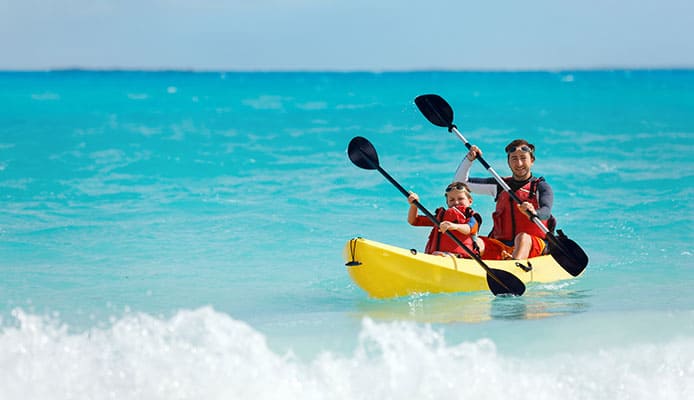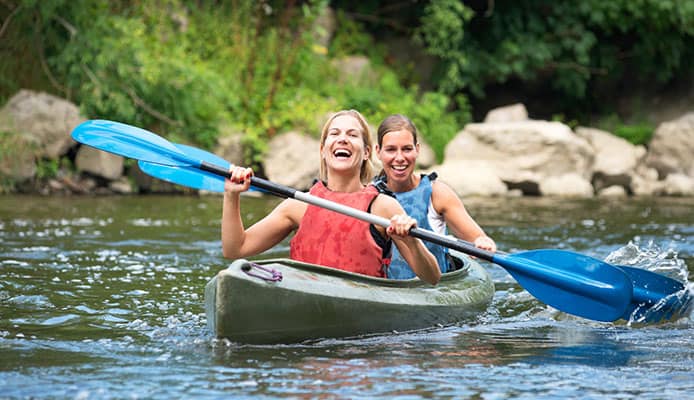
It’s a no brainer, kayakers who bring a safety kit during their paddling adventure face less danger if their kayaks tip over than those who don’t.
Accidents are inevitable and could happen even to those highly skilled kayakers. It is therefore important to always have some safety equipment on board just in case.
However, sometimes it’s hard to decide what you need to put in your kayak safety kit and what you don’t. You will encounter different opinions from different people on how to prepare a kayak safety kit but at the end of the day, it’s all up to you.
There is nothing right or wrong. Just think about where you will be going, whom you will be going with, and what you might need if things start going sour.
Tips On Selecting The Contents Of Your Kayak Safety Kit
- Make sure the kit is light enough. If it’s too large, it may occupy unnecessary space on your boat or even worse, get too heavy to carry.
- The kit must be waterproof. Remember you will be carrying it in your kayak where there is a high possibility of it getting wet. So get something that doesn’t let water in.
- The kit must be tightly tied to your kayak or yourself. If it is loose and you happen to flip over, you might lose the only thing that could save your life.
- If possible, every item should serve multiple purposes. This will solve the problem of bringing so many items that could overload your watercraft.
- Every component should work perfectly in both mild and extreme weather conditions
Basic Kayak Safety Kit Components
Now that we have already pointed out how to prepare a kayak safety kit, what items should go in there? Let’s find out!
1. Paddle Float
This is your best means of climbing back into your kayak after a capsize, especially if you are alone. A paddle float is attached to one of the kayak paddle blades to stabilize the boat for re-entry. However, you can only use it if you have been trained on how to. Otherwise, you will just be staring right at it as you slowly sink into the waters.
2. Bilge Pump
Once you have rolled back onto your kayak, you must remove the water that had collected inside. A means of emptying water, and in this case a bilge pump, will be an essential piece of safety equipment.
You can go for a simple, inexpensive hand pump. Just as the name portrays, this is a short tube that contains hand-pressed pump handles to pull water from the kayak. The best thing about it is that it is easy to use and draws the water without much effort. Plus it comes with a foam collar that enables it to float on water so you don’t have to worry about losing it even if it falls in the ocean.
You can also install a foot-operated bilge pump in your kayak but this will be way expensive than a simple hand pump.
3. Whistle
Quite often when we are caught in a life-threatening situation, the first thing that comes to our minds is to yell, shout, scream, or make whatever sound that can alert others that we are in danger. That’s how our mind is made. Unfortunately, this life-saving trick may not work in a water environment. With the noise from the winds and water currents, it can be difficult for people to hear your voice.
That’s the whole reason why you need a whistle. This small piece of equipment could literally save your life. Many paddlers ignore its power but when they find themselves in an emergency, they wish there were better ways to attract attention to themselves other than shouting for help. If only they brought their whistles along!
4. Paddle Leash
When thinking of how to prepare a kayak safety kit, don’t forget to include a paddle leash in the safety gear. This is the only way to ensure that you don’t lose your oar in the event your kayak capsizes or is hit by a wave.
Though we always recommend having an extra paddle on board, having a leash will save you the hassle of looking for the backup paddle when you are in danger. To make it easier for you to recover your oar, tie one end of the leash to the paddle and the other one to your wrist or the hull of your boat.
If you are taking photographs in your kayak and happen to drop your oar or if you are paddling at a spot that has high swells, losing your paddle only means one thing – you are not going to navigate your boat anymore! However, if your kayak gets swayed away by waves and you are left holding the paddle, you will be in big trouble too.
For this reason, it would be wise to attach your paddle to your kayak, but then if you capsize you will need to hold on to the paddle. That way, you will be able to save both your kayak and the paddle.
5. Knife

Tell your buddy that you will be bringing a knife to the kayaking trip and they will be left wondering what you are planning to kill out there. They won’t understand until you tip and end up entangled with some cord or seaweed and the knife is the only savior.
Including a knife in your safety kit would be a great idea especially if you will be paddling in seaweed “infested” areas. Just make sure to get a model that won’t be corroded by the saltwater.
6. Signaling Mirror
Maybe you are wondering why you need a signal mirror when you already have a whistle, right? Wrong! Of course including a whistle in the list while deciding on how to prepare a kayak safety kit is imperative, but throwing in a mirror too is equally important.
The whistle will enable other paddlers to hear your but a mirror will get them to see you. However, mirrors will only be effective if the weather is clear.
7. Radio
If your trip is going to take more than a day, you may want to bring a radio. This will keep you informed about the weather changes, which is very important especially if you are riding an inflatable kayak. You need to know how hot or cold the weather will be, as this will help you adjust the air pressure of your kayak accordingly.
Not only that. Keeping up to date with weather changes will help you dress appropriately for the day. You really don’t want to be in a bikini when everyone else is wearing a dry suit, neither do you want to be in boots when everyone else is in sandals.
Knowing the state of the atmosphere beforehand will also protect you from weather-related conditions like an ice-cream headache, colds, surfer’s eye, and more. So do yourself a favor, include radio in your kayak safety kit and you will have a safe and enjoyable trip.
8. Torch
Paddling is fun. However, sometimes we get so absorbed in it that we actually forget to check the time to know when we should start heading back to the shore. That’s why it is always a good idea to have a flashlight just in case it gets dark when we are out there.
A torch will help you trace your way back to the shore and keep you visible by night kayakers. You can also use it to signal for help if something goes wrong when paddling in a misty or foggy area where there is poor visibility.
9. Towline
This is especially helpful if you are paddling as a group. A member could get sick or injured and the best way to bring them back to the shore is by towing their boats. One end of the towline is fastened on the hull of the kayak or the waist of the person who is towing and the other end is tied to the kayak being towed.
10. First Aid Kit
Whenever we head out for picnics in the woods, a first aid kit is the first item we pack in our bags, so why should this trip be different? The dangers we are likely to encounter in the waters could be twice as hostile as those in the woods could. So make sure to include this in your safety kit. You don’t want to abort your paddling just because of bleeding from a cut that could be stopped with a simple first aid.
Globo Surf Overview
If you have been wondering how to prepare a kayak safety kit and what to include in it, we believe the information given in this article will give you the insight you need. Having a safety kit is essential for any kayaking trip or any other water activity. It keeps you ready for emergencies and helps you get back to the shore safely. Just make sure it is waterproof and firmly secured to your kayak so that you don’t lose your items in case you capsize.
More Kayak Reviews:
- Ocean Fishing Kayak
- Gifts For Kayakers
- Kayaks For Big Guys
- Kayak Covers
- Kayak Flag
- How To Tie Down A Kayak In A Truck Bed
- Kayaking In Oregon
- Kayak Bulkhead
- Voyager Kayak
- Kayak Surfing
Sources
- Build Your Kayak Safety Kit, inflatablekayakworld.com

